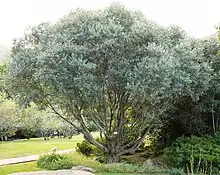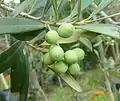Olea europaea subsp. cuspidata
Olea europaea subsp. cuspidata is a subspecies of the well-known olive tree (Olea europaea), which until recently was considered a separate species (Olea africana) and is still mentioned as such in many sources. Native to northeast of Africa and the drier parts of subtropical Asia, it has various common names, including wild olive, African olive, brown olive and Indian olive.[2]
| Olea europaea subsp. cuspidata | |
|---|---|
.jpg.webp) | |
| Scientific classification | |
| Kingdom: | Plantae |
| Clade: | Tracheophytes |
| Clade: | Angiosperms |
| Clade: | Eudicots |
| Clade: | Asterids |
| Order: | Lamiales |
| Family: | Oleaceae |
| Genus: | Olea |
| Species: | |
| Subspecies: | O. e. subsp. cuspidata |
| Trinomial name | |
| Olea europaea subsp. cuspidata | |
| Synonyms[1] | |
| |
It is the ancestor of the cultivated olive and it has been introduced to Australia, New Zealand and the US. It is an aggressive invasive species that can infest dry woodland areas, riparian zones, headlands and dune systems.[3]
Description


This much-branched evergreen tree varies in size from 2 to 15 metres (7 to 50 ft) high. The leaves have an opposite, decussate arrangement, and are entire, 3 to 7 centimetres (1.2 to 2.8 in) long and 8 to 25 millimetres (0.3 to 1 in) wide; the apex is acute with a small hook or point, and the base is attenuate to cuneate.
Leaf margins are entire and recurved, the upper surface is grey-green and glossy, and the lower surface has a dense covering of silvery, golden or brown scales. Domatia are absent; venation is obvious on the upper surface and obscure on the lower surface; the petiole is up to 10 millimetres (0.4 in) long.
In drier areas, the plant may be less than 1 metre (3 ft 3 in) tall within 5–10 years, though it may still reach sexual maturity at around five to six years when it is a shrub at 4 metres (13 ft)} high. In the right conditions, the plant can reach its full height of 10 to 13 metres (30 to 40 ft) between 8 and 12 years.[3]
Inflorescence and fruit
The flowers are small and inconspicuous, usually appearing in spring. The calyx is four-lobed, about 1 millimetre (0.04 in) long. The corolla is greenish-white or cream; the tube is 1 to 2 millimetres (0.039 to 0.079 in) long; lobes are about 3 millimetres (0.12 in) long and reflexed at the anthesis. The two stamens are fused near the top of the corolla tube, with bilobed stigma.
Fruit are borne in panicles or racemes 50 to 60 millimetres (2.0 to 2.4 in) long. The fruit is edible but bitter. The globose to ellipsoid fruit is a drupe, 6 millimetres (0.24 in) in diameter and 15 to 25 millimetres (0.59 to 0.98 in) long; it is fleshy, glaucous to a dull shine when ripe, and purple-black.
Distribution
It is extensively found through Africa (i.e. Egypt, Eastern Africa, Central Africa and Southern Africa), the Mascarenes (i.e. Mauritius and Réunion), western Asia (i.e. Arabian Peninsula, Afghanistan and Iran), the Indian sub-continent (i.e. northern India, Nepal and Pakistan) and western China. Subtropical dry forests of Olea europaea cuspidata are found in the Himalayan subtropical broadleaf forests ecoregion.[4]
In areas where it is not native, such as Australia, it is classified as an environmental weed spread mainly by birds eating the fruit. It is widely naturalized in New South Wales, Victoria, South Australia and Western Australia, where it is found in bushlands, parks, roadsides and waste areas on the coast and in highlands, where it would alter the original composition of the native vegetation. It was first introduced to Australia in the mid 19th century for ornamental reasons.[5]
Uses
The wood is much-prized and durable, with a strong smell similar to bay rum, and is used for fine furniture and turnery. The wood is strong, hard, durable and heavy and resistant to termites and wood borers. The spindle wood is very light, while the heartwood is dark yellow to reddish brown.
This species is cultivated as an ornamental tree for parks and gardens. It is also used for the production of table olives and oil. The sap of the fruit of this tree can also be used to make ink.
Gallery
.jpg.webp) Flowers
Flowers Leaves
Leaves Unripe fruit
Unripe fruit_-_Jard%C3%ADn_Bot%C3%A1nico_de_Barcelona_-_Barcelona%252C_Spain_-_DSC09253.JPG.webp)
 Ripe fruit (dark purple)
Ripe fruit (dark purple) Trunk of old tree
Trunk of old tree.jpg.webp) Seedling infestation
Seedling infestation
References
- "Olea europaea subsp. cuspidata". World Checklist of Selected Plant Families (WCSP). Royal Botanic Gardens, Kew. Retrieved 10 August 2017.
- "Olea europaea subsp. cuspidata". Germplasm Resources Information Network. Agricultural Research Service, United States Department of Agriculture. Retrieved 27 June 2014.
- Olea europaea subsp. cuspidata (wild olive) CAB International. Retrieved 17 January 2022.
- Olea europaea L. subsp. cuspidata (Wall. ex G. Don) Cif. by Special edition of Environmental Weeds of Australia for Biosecurity Queensland (Queensland Government). Retrieved 3 February 2021
- Olea europaea subsp. cuspidata (Wall. ex G.Don) Cif. WEEDS AUSTRALIA - PROFILES. August 2007. Retrieved 3 February 2021
External links
 Media related to Olea europaea subsp. cuspidata at Wikimedia Commons
Media related to Olea europaea subsp. cuspidata at Wikimedia Commons